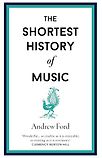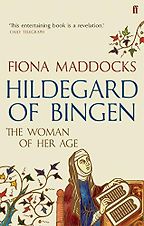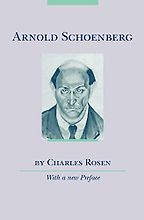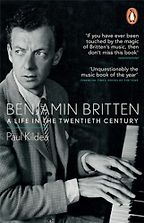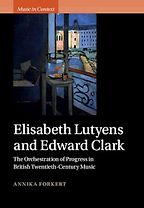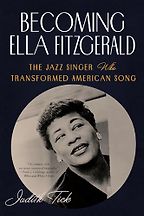Do you want to start by giving an introduction to how you chose these biographies? I think you have quite strong views about how to approach the history of music as a writer. Maybe you could start by telling us about that.
It’s very difficult to write about music because, as one of my favorite musicologists, Wilfrid Mellers, once said, if you’re not writing technically about music, you’re not writing about music at all. You’re writing about something else. I’ve always taken that to heart and tried to keep it in mind when I write about music.
The problem is that in order to write technically about music, there is all of this jargon, and most readers don’t understand the jargon. So you have to try, somehow, to either explain the jargon along the way or avoid it and try to use everyday terms. The jargon is a time saver for people who understand it. That’s why it’s there, it’s a series of shortcuts. But there’s no point in using it if you’re writing for a general audience, which isn’t going to understand it. And it’s really only general audiences that I’m interested in writing for.
So biography was important to your approach in writing The Shortest History of Music?
I wrote about what I thought were the important ways we have used music as a society and the way in which music has developed in different ways, in different places, at different times. All you can do is give some examples, and a lot of those examples are biographical. I needed to hit upon some key figures, not necessarily the greatest musicians who ever lived, not necessarily even the most interesting ones, but the ones who helped me to tell the story, because they were doing something at a particular moment that exemplified what other people were doing.
It was the same with pieces of music. There are so many famous pieces of music that are not mentioned in the book. The ones that I chose are not my favorites and not the ones that I think are the greatest. Some of them are, but they’re there because they help to tell a story.
I wasn’t terribly aware of this while I was writing the book, but after I finished, I could see what I had done, and it was clear that biography had played quite a large part in this process.
Let’s go through the biographies you’ve chosen. First up is the book by Fiona Maddocks about Hildegard of Bingen (2013). Do you want to say who Hildegard of Bingen was and why she’s important to the history of music and, also, why you recommend this particular book—because I think quite a few have been written about her?
Yes, they have. For the general public—and I include myself in this—Hildegard came into our lives about 40 years ago with a recording called “A Feather on the Breath of God”, which is a line of Hildegard’s, by Gothic Voices. Musicologists had known about Hildegard a lot longer than that and there’s plenty of scholarly writing about her going back to the 19th century, which Fiona Maddocks brings out in her book.
Hildegard was an extraordinary figure. She was an abbess who ran an abbey in the Rhineland in the 11th- 12th century. She was an administrator, but also a scientist, a medic, a philosopher, a theologian and quite an interesting writer. She wrote poetry, she wrote plays, and she wrote what is almost the first opera, although she wouldn’t have known that that’s what it was—a kind of sung play.
Hildegard composed these songs, hymns and sequences that were really strikingly original, mostly for the fluidity of the melodic writing. There was only melodic writing—that’s all you get with Hildegard. But at the time, it was thought by the Church that a melodic line should span maybe a fourth or a fifth, so half an octave. Some of Hildegard’s go across two octaves. They have an enormous range and floridity.
In a way, you could say that it is pictorial because she is not only composing her music to the glory of her God but also drawing very heavily on the imagery of the natural world. One of the things that she became very interested in depicting is what she called viriditas or greenness. She meant it in the same way that we would think of that word perhaps today, in modern political terms: she was talking about the importance of the natural world and preserving it and its use in healing. But it’s also a symbol for her faith. For instance, the title of one of the songs is “O Viridissima Virga” or “The Greenest Branch.” ‘Virga’ is obviously the same stem that gives us virgin and so it’s also about the Virgin Mary.
So it’s this confluence of the natural world, and her study of the natural world, with her faith. All of that is represented in the music. You sense the melodic line twisting around itself like the tendrils of a plant. That’s also the Tree of Jesse, so everything is intertwined.
In the book, Fiona Maddocks does a fantastic job of bringing together everything about Hildegard that had gone before. She’s read very widely. She illuminates the world of Hildegard and the times in which she lived. She was an important figure in terms of the Church and had a long correspondence with Bernard of Clairvaux. She was not un-controversial. Some of her views and her music didn’t sit within the norms of the medieval Church.
What I like about this book—and I think this is probably true of all of the books that I’ve chosen—is the way in which it situates the figure that it’s writing about within her world.
Don’t you also say in The Shortest History of Music that her work was a bit of a milestone in terms of the annotation and writing down of the music?
That happens around about the same time. A monk called Guido of Arezzo came up with not only what we now know as Do Re Mi Fa So La Ti Do, but also staff notation. The modern score, the five lines with the dots that you would find on a concert platform or in a studio with session musicians—that’s Guido. His only had four lines, but he invented it.
This allowed Hildegard and anybody else who was interested in composing music to plan it out on the page. Before it wasn’t done that way. You made up a tune in your head and you passed it on orally, or maybe you tried to find some way of notating it.
There were earlier forms of notation, but they’re tablature. Guitarists and ukulele players still use tablature, as do a lot of the world’s instruments. The shakuhachi and koto, for instance, in Japan, have forms of tablature. Tablature tells you where to put your fingers, and it might also tell you how hard to pluck a string. It’s a set of instructions which you follow to produce the music, it doesn’t show you the music. Guido’s invention does. You can open it, and if you can read music, you can hear it in your head.
None of this is the music, of course. It’s important to recognize that the music is what you hear. It’s not what’s on the page, even though you might be able to hear it in your head. It’s something which is brought to life all the time. Music exists in the present, always, whether it’s in your memory or in the performance that you’re hearing in a concert hall or in the recording you’re listening to. It’s always happening now.
Let’s go on to the next book, which is a biography of Arnold Schoenberg (1976) by Charles Rosen. Tell me about the significance of this Austrian American composer and why you’ve included this book.
Schoenberg was a key figure in 20th-century music. He was perhaps not as key as Charles Rosen thought, but at the time he wrote this book, in 1976, he was certainly regarded as vital. Schoenberg had been dead for only 25 years, and he had left his mark on most composers. Whether they followed him or rejected him, they had to make a choice about where they stood.
It’s a big life. Schoenberg was born in Vienna in 1874 and died in Hollywood in 1951. He was Jewish and when Hitler came to power in 1933, he left Europe almost immediately and went to the United States.
What is still misunderstood about Schoenberg is that he was very much a traditionalist—because he was a radical too. He came out of the Austro-German tradition, following on from Brahms and Wagner and going back to Bach. When he taught, those were his exemplars. One way of looking at that tradition is that music is about progress, it goes forward and one thing leads to another.
In particular in Wagner, music harmonically had reached a crisis where it had become more and more chromatic (one of those technical terms I mentioned). Chromaticism is a harmonic complexity, and it involves dissonance. Most music involves dissonance. Even Hildegard’s music involves dissonance, though it’s generally resolved. It goes from a dissonance to a consonance—that’s where you get the emotion in music. That’s true of an Indian raga every bit as much as a Western symphony. But in the hands of Wagner, that resolution was increasingly delayed, so that for great stretches of Wagner you don’t know what key you’re in and when the music does resolve…well, you could argue that in Tristan and Isolde, it doesn’t resolve until the end, after four and a half hours.
Based on that experience of the music of the past, Schoenberg thought, ‘Right. The next step is to do away with keys.’ It was like Neil Armstrong: one small step for Schoenberg, but a giant leap for audiences. I think that’s why Schoenberg is regarded as radical—but it’s important to know where he came from.
Charles Rosen is very good at spelling this out in his little book. It’s a tiny book. It’s even shorter than mine, just 116 pages of text. It’s one of those books I remember where I was when I read it. I was on a train going from Lancaster, where I was at university, to Nottingham, where my girlfriend was at university. I read it during the course of that train journey, and it really did change the way I thought about Schoenberg and music in general. I remember thinking, ‘This explains not only Schoenberg but all of modern music.’ And perhaps, at the time, it almost did.
But it certainly doesn’t anymore because music moves on. One of the things that we’ve seen is that the idea of progress, which is central to Rosen’s book, is viewed with great suspicion in all areas of life, pretty much—with the possible exception of plumbing.
So it’s a bit out of date, but it’s still a very good book. One of the reasons it’s so good is that Rosen, in addition to being a great scholar of not just music but the arts in general, was also a very fine pianist. He had played and recorded all of Schoenberg’s piano pieces, the piano concerto and the songs. He knew the music inside out, and he writes about it very, very well. The music examples in the book are very few and far between. Again, he was writing for the general reader.
The book was part of a series called Fontana Modern Masters, which included Al Alvarez on Beckett and Conor Cruise O’Brien on Camus. I don’t think there’s a single woman among the ‘modern masters’ and not among the writers either, now that I come to look at it. So it’s not just our attitudes to Schoenberg that have changed in the last 50 years. But this is still a book that I would heartily recommend because, like the book about Hildegard, it says so much about the music as well as the life, and it puts the life firmly in the context of the times.
Let’s turn to the biography of the British composer Benjamin Britten (2013) by Paul Kildea.
This is a great big, heavy book of 600+ pages. It’s exactly the opposite kind of book to Rosen’s little monograph. Again, it’s by a musician. Paul Kildea is a conductor and a pianist, as well as a music administrator and the author of other books, including editing a collection of Britten’s own writings. Britten is very much his specialty.
I was looking at this book again today and realizing how rich and fully researched this life is. It’s so detailed. Whilst it’s a life of our time—Britten died in 1976—it’s surprising what we don’t know about him. In spite of the huge archive of letters and diaries, it’s still not always easy to know what was going on inside Britten’s head. He was a rather private figure, and a lot of it is guesswork.
There is a danger that we always assume that a composer is composing their own life. In Schoenberg’s case, his Viennese origins and his moving to America and ending up in Hollywood is a fascinating backdrop to the music—but I don’t know that it necessarily explains the music. In Britten’s case, he was incredibly strait-laced. He was in a gay relationship that everybody knew about but was not acknowledged because it wasn’t legal until the last decade of his life. You get the impression that Britten himself disapproved of his homosexuality.
The other thing that comes out in the book is that he never properly grew up. His famous association with boys was probably at some level erotic in his mind—there’s no suggestion that he ever acted on it—but it was also him wanting to stay a boy. He wanted to be the clever schoolboy rather than the famous man.
There’s a sense with Britten that the music itself is rather stitched up, and none the worse for it. It doesn’t always wear its heart on its sleeve. Sometimes it’s more difficult to penetrate emotionally when you listen to it. I’m an enormous admirer of Britten’s music and I find him an endlessly fascinating figure—possibly because he’s so difficult to know and wants to keep us at arm’s length.
So when somebody like Paul Kildea comes along to write a biography and to try to get underneath that surface… Many people have written biographies of Britten and attempted it, but it’s a tall order. Kildea does it so well because he knows the music so well. This is very much a life and works. It’s called Benjamin Britten: A Life in the Twentieth Century, but the music is always there. Kildea writes beautifully about the music and integrates it into the narrative of the life. You end up wanting to go away and listen to everything again, which, ultimately, is the acid test of any book about music—that it sends you back to the music.
In terms of your book and placing Britten within the history of music, where does he fit in?
He’s with the Byzantine Empire—he’s not even mentioned. I would love to have put Britten in the book. I’ve often written about him in articles. As I’ve said, many of my favorite composers didn’t make the final cut of my Shortest History of Music.
Where would he have gone? Goodness. He was not sympathetic to Schoenberg. One of the things that you find in Britten is a sense of continuity with the past in a harmonic sense. Britten is very distinctive but he’s seldom atonal, and when he is it’s only for a particular, dramatic reason. So there’s that, musically speaking.
The other thing is that he showed the continued viability of opera as a commercial enterprise. He set up his own opera company, and he made it work in the way that Handel had done in the 1700s in London. We have come to think of opera as a high-end commodity that is only appreciated by snobs and can only be attended by the very rich. But that’s not its origins. Even today, if you go to an opera house in Italy, there are families with picnics sitting up in the gods. It’s not just a connoisseur’s art form. In his rather short life, Britten was very good at proving that and putting out operas which were quite modern but had a very broad appeal. In its first year, Peter Grimes had a ridiculous number of performances all around the world and not just in Europe. There’s not really been anything since on a par, operatically speaking.
Let’s go on to the next book. This is about Elisabeth Lutyens and Edward Clark: The Orchestration of Progress in British 20th Century Music (2023). Tell me more.
Elisabeth Lutyens was the first composer I ever saw in the flesh, so she has a tiny place in my heart for that reason alone. She was a rather imposing figure who spoke with these cut-glass vowels. You would see her sometimes at concerts. I was far too scared to go and speak to her, but you couldn’t help noticing her. She was the daughter of Edwin Lutyens, the architect of New Delhi, and her mother was one of the Bulwer-Lyttons so she was essentially aristocratic.
She was also just about the first composer in England to take up Schoenberg’s invention of the 12-tone system—the way he formalized his harmony after abandoning tonality. It was regarded as very continental and not the kind of thing English composers did, but Lutyens did it. In a way this book—which is a double biography of Lutyens and her second husband, Edward Clark—shows how that came about.
Again, there are things missing. Edward Clark was a conductor who had studied with Schoenberg at the beginning of the 20th century. But he wasn’t a composer, and we don’t know what he studied. Annika Forkert, the author of this book, is frustrated at not being able to find that out. It’s one of the things we still don’t know.
When he met Elisabeth Lutyens, Clark had been working at the BBC but had left. We’re not quite sure why. But the two of them got together. It wasn’t the most satisfactory of marriages. Clark felt that if he couldn’t be a conductor—which he couldn’t, because he’d lost his work with the BBC—then he didn’t want to do anything.
So it fell to Lutyens, who had three young children from her first marriage and now a new baby with Clark, to try and earn money. As the only 12-tone composer in England, that was never going to be easy.
I didn’t know much about Clark. His greatest claim to fame was the contents of his phone book because he knew Arnold Schoenberg, Alban Berg, Anton Webern, Igor Stravinsky, Béla Bartók and Maurice Ravel and was able to bring them to the BBC to do concerts in London before the Second World War. He helped to make London into a cosmopolitan musical place. But by the time he got together with Lutyens that had all gone and it fell to her to support him.
Lutyens is a fascinating figure. She was a great teacher. Her students were very loyal to her in spite of her anti-Semitism. She would say terrible things to her Jewish students, and yet they still spoke highly of her. They felt a sense of protectiveness towards her, perhaps, because she was depressed and an alcoholic and had a difficult life.
Lutyens wrote a lot of music, including for Hammer Horror films. That’s where she took her 12-tone system and it worked: people actually wanted it and paid for it. So she spent a lot of time writing scores for film as well as for radio dramas and occasionally TV.
Annika Forkert writes very sympathetically about both Lutyens and Clark, even though they were both impossible figures in their own ways. I like the idea of double biographies. One book that I almost chose—it was certainly the best book I read about music last year—was Jeremy Eichler’s book Time’s Echo, which is a four-way biography of Richard Strauss, Arnold Schoenberg, Benjamin Britten and Dmitri Shostakovich. Eichler is writing about the pieces that they composed in response to the Second World War and the Holocaust. He uses a lot of biography but they’re not full biographies—it’s only a portion of each of their lives. It’s so interesting to put these different lives together within one book.
Do you listen to Lutyens’s music now?
I do occasionally. It’s uneven. Most people would accept that she often wrote too fast, and you can see why—she was trying to pay bills. Some of her music is very beautiful.
As I said, the list of composers who studied with her is quite long and impressive and their loyalty suggests that they felt that they owed her something. Possibly it was a way of thinking about music and of being a composer. The fact that she was the first composer I ever saw—when she came out on stage to take a bow after one of her pieces was performed at the Proms…in a way, she showed me how to be a composer as well, although I never studied with her.
Let’s turn to your final recommendation, Becoming Ella Fitzgerald: The Jazz Singer Who Transformed American Song (2023) by Judith Tick.
Like all of these books I’ve chosen, it’s a life in the context of the times and a musical life in the context of the music. Like Britten, we don’t know everything about Ella Fitzgerald. We’re not even sure how many times she was married. That’s extraordinary, given how famous she is and was in her lifetime.
With Billie Holiday, who was Ella’s contemporary, we feel we know everything about her life, you can sort of hear it in her singing. One of the things we could say if you compare the two—and it’s always tempting—is that you are always aware, with Billie Holiday, of her blackness, and not just when she sang “Strange Fruit”. With Ella Fitzgerald, it was possible for her fans to be oblivious to her race. In their minds, she had transcended it.
It was partly the way in which she was presented and the work she did with the Great American Songbook. In the mid-1950s, she started recording Cole Porter, George Gershwin and Harold Arlen and all of those great 20th-century composers of American pop songs. In a way, she was providing the definitive versions of many of those songs. They came out as albums, in some cases with three LPs in them. For instance, there’s the Ella Fitzgerald Sings the George and Ira Gershwin Song Book. She made herself an authority on them.
What we do know of her life is partly at odds with that but, also, I think the details are scant because she wanted them that way. This is a problem for Judith Tick, writing a biography of somebody who was intensely private and deliberately didn’t let out details.
Tick discovers things that had not been known before but is still guessing about others. She’s very diligent as a biographer. She won’t claim things that she doesn’t have evidence for. For example, there’s a suggestion that Ella was maybe abused as a child, but this is based on one occasion when she said something to a relative. Tick tells us that, but she doesn’t make a big thing of it, because there isn’t enough evidence. You need more to go on than a chance remark. That’s typical of her general approach to writing this biography.
Having said that, she has access to an enormous amount of material regarding the concerts and the recordings. You get chapter and verse about what Ella sang on which occasion, how she put together her repertoire, and how she turned the voice into a jazz instrument. When Ella started out singing with dance bands, the singer’s job was to sit there and stand up at some point and sing a chorus, before sitting down again. It was the singer’s job to remind the listener what the song was and what the words were but it was the sax players and trumpeters who did the jazz.
Through her career, Ella changed that. She didn’t do it singlehandedly, because Billie Holiday did it too, but it was Ella more than anybody else. She did it partly by teaming up with beboppers like Dizzy Gillespie, where you didn’t really use the words, you scatted instead; and so her voice became an instrument.
One of the things that I like so much about Tick’s book, which only came out in 2023, is the way in which she is able to take the details that we have of Ella Fitzgerald’s life and apply them to the art.
The subtitle, “The Jazz Singer Who Transformed American Song”, is really important because that’s what she shows in the book. Ella Fitzgerald was able to reinvent the role of the singer in jazz and turn it into something which was not a poor relation to the horn players, but an absolute equal. Ella knew what she wanted. She was a band leader as well. She had a tremendous musical brain.
Interview by Sophie Roell, Editor
February 15, 2025. Updated: February 25, 2025
Five Books aims to keep its book recommendations and interviews up to date. If you are the interviewee and would like to update your choice of books (or even just what you say about them) please email us at [email protected]
Five Books interviews are expensive to produce. If you've enjoyed this interview, please support us by donating a small amount.

